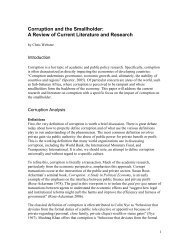13th Annual International Management Conference Proceeding
13th Annual International Management Conference Proceeding
13th Annual International Management Conference Proceeding
Create successful ePaper yourself
Turn your PDF publications into a flip-book with our unique Google optimized e-Paper software.
DEVELOPING INTRAPRENEURSHIP IN SMALL BUSINESSES<br />
Esther Njiru,<br />
M.Ed, PhD Candidate (Entrepreneurship Development)<br />
ABSTRACT<br />
The performance of small businesses has come to the forefront with the realisation that a vast majority of business<br />
start-ups do not survive beyond the second year. Various reasons have been levelled to this problem of business<br />
closures: the main problem is the lack of demand for individual enterprise products and services resulting from stiff<br />
competition. This is closely related to the lack of markets access. There is also reportedly a lack of credit, lack of<br />
security and poor cooperation from public authorities, lack of raw materials and problems related to the worksite.<br />
The need to be self-sustaining demands the continuous improvement of service and/or product provision and<br />
marketing the products or services in a liberalised market. In the context of increasing market globalization and free<br />
trade, firms must innovate constantly to improve their flexibility, competitiveness, and reactivity. As Stevenson and<br />
Jarillo (1990) pointed out, intrapreneurship has grown in importance over recent years because large firms wishing to<br />
compete have sought out the characteristics of flexibility, growth, and innovation more generally associated with<br />
entrepreneurship. Many authors have highlighted the importance of intrapreneurship as a stimulus to innovation in<br />
organizations. This paper posits that many businesses that start with high notch do not survive because the<br />
entrepreneurial spirit is not sustained since they have not become intrapreneurial. In a review of literature, this paper<br />
explores the concept of intrapreneurship and describes how small businesses organisations can survive through<br />
developing intrapreneurship.<br />
1.0 INTRODUCTION<br />
There has been a great deal of attention paid to the subject of entrepreneurship over the past few years,<br />
stemming primarily from the discovery by economic analysts that small firms contribute considerably to<br />
economic growth and vitality. Moreover, many people have chosen entrepreneurial careers because doing so<br />
seems to offer greater economic and psychological rewards as well as some level of independence than does<br />
the large company route.<br />
In Kenya, a mushrooming informal sector has been the response to stagnating employment growth in the<br />
formal economy and the downsizing of parastatals and of private companies as they reduce costs in a<br />
liberalizing environment. These causal factors are combined with one of the fastest population growth rates<br />
in the world, requiring the economy to absorb annually about 500,000 new labour market entrants. Micro<br />
and small enterprises (MSEs) account for more than 90% of businesses worldwide and create 50 to 60<br />
percent of employment (Kangari, 2006). It is estimated that today, Kenya’s informal sector constitutes 98<br />
percent of all businesses in the country, absorbs annually up to 50 per cent of new non-farm employment<br />
seekers, has an employment growth rate of 12-14 percent, contributes 30 percent of total employment and 3<br />
percent of Gross Domestic Product (GDP) ( Riley and Steel, 2000).<br />
1.1 Challenges facing small businesses<br />
For the purposes of the paper, small businesses will be defined as organization with less than 50 employees.<br />
Small businesses have a long-term vision to grow into big enterprises. To this end the small businesses<br />
attempt to overcome any obstacles to expand. They tend to be very robust with high growth rate. Numerous<br />
challenges hinder growth and hence a high rate of collapse. The Small Business Administration website<br />
shows that "two-thirds of new employer establishments survive at least two years, and 44 percent survive at<br />
least four years." In Kenya, 50 percent of businesses fail in the first year and 95 percent fail within five years<br />
(Central Bureu of Statistics, et al, 1999).<br />
Opinions abound about what a business owner should and shouldn't do to keep a new business afloat in the<br />
perilous waters of the entrepreneurial sea. Below is a list of some reasons why businesses fail from a variety of<br />
writers: starting the business for the wrong reasons e.g. to get rich quickly; Poor <strong>Management</strong>; Lack of<br />
Planning so the business has grown too fast; Over expansion; the business doesn't make profits; the owner<br />
42
















